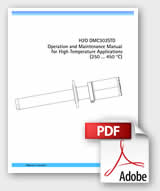There are various industrial dryers utilized in production facilities. The dryers include spray dryers, flash dryers, rotary (both steam and direct fired), conveyor dryers and many others. Most of these dryers are typically controlled using the exhaust gas temperature as a set point and then control the inlet temperature or feed rate to keep the set point constant. Industry uses exhaust temperature sensors as surrogates to product moisture sensors or exhaust humidity ... Read More
Recent Posts
In a recent test on a flash dryer, we tested out the product moisture prediction equation found in “The Handbook of Industrial Drying, Fourth Edition” for flash dryers:
X=K1*ln (Ti-Tw/To-Tw), where: &nb... Read More
Industrial dryers and ovens are major sources of energy consumption in various business segments. Pulp and paper, petrochemical, chemical, insulation, wallboard, pet food, corn wet milling, food, cement and lime are just some of these business segments. One of the most important variables in drying is to control exhaust humidity to a certain humidity content. If the humidity content is too high, evaporation rates can be affected and condensation on backend equipment c... Read More
What Is a Dry Scrubber?
- In dry scrubbing, lime is injected directly into flue gas to remove SO2 and HCl. There are two major dry processes: “dry injection” systems inject dry hydrated lime into the flue gas duct and “spray dryers” inject an atomized lime slurry into a separate vessel. A spray dryer is typically shape... Read More
In today’s power production environment, thermal cycling is more common which stresses process equipment causing higher tube leak rates. The forced outage rate in 2019 for power plants was 6.97%. Forced outages for combined cycle plants typically cost a plant $110,000 in fines, repairs and lost income. Other causes of tube leaks include acidic / dew point corrosion from process gas and flow accelerated corrosion (FAC). We will review the diagnostic techniqu... Read More
There are many industrial processes that contain acid or caustic gases. Power plants, potash dryers and ore processing are just a few harsh industrial environments. These applications need accurate humidity and temperature sensors to control the process efficiently. Humidity also has a large impact on the acid gas dew point temperature. In most applications, the plant wants to keep the process temperature above the acid dew point temperatu... Read More
Many industrial process gases have high particulate loading. Measuring process parameters (ie. humidity, particulate size, oxygen content) can be very challenging. The key issues are maintenance and blinding of the sensor. For a humidity sensor to be useful, the maintenance must be low or the plant will not be able to use for control. Blinding causes the sensor to not respond to process changes which provides inaccurate ... Read More
An accurate, reliable humidity measurement has always been an issue for high temperature, high particulate, corrosive and condensing environments. Most OEM (dryer, boiler, kiln, HRSG…) manufacturers do not include humidity sensors as part of the control package because of the increased cost to the customer. Another reason is that there are a lot of humidity sensor technologies that will not work in those environments and the OEMS do not want to expose themsel... Read More
H2O / Wet Bulb Sensor Rental Program for Smokehouse & Oven Applications The sensor provides real time absolute humidity in the exhaust of any dryer, oven or kiln. Particulates, organics, liquid smoke, natural smoke and condensing compounds have no effect on our sensor. The sensor is a direct measurement of the water molecule and is very repeatable so that the plant can dial into the same number every time with confidence. The accuracy of our sensor at 90C is 0.1%... Read More
Combustion boilers utilizing fuels with varying moisture can see varying steam loads based on the fuel variability. The more information the plant knows about the fuel moisture, the better the plant can plan accordingly to provide a more stable steam load. Since waste to energy fuels have varying components, it is very hard to measure the fuel moisture on a real time basis prior to entering the furnace. The same can be seen in biomass boiler applications. Another option to direct fuel m... Read More



